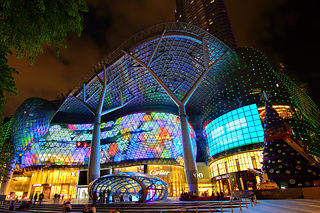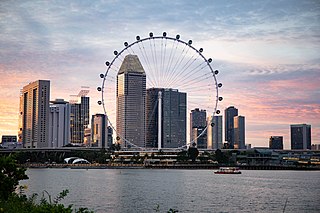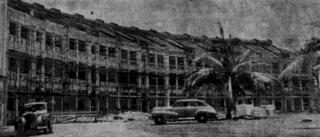Related Research Articles

Marine Parade is a planning area and residential estate located on the eastern fringe of the Central Region of Singapore. Straddling the tip of the southeastern coast of Pulau Ujong, Marine Parade serves as a buffer between the Central and East regions of the country. Bordering it are the planning areas of Geylang to the north, Kallang to the northwest, Bedok to the northeast, Marina East to the southwest and the Singapore Straits to the south.

Orchard Road, often known colloquially as simply Orchard, is a major 2.5 km (1.6 mi)-long road in the Central Area of Singapore. A famous tourist attraction, it is an upscale shopping area, with numerous internationally renowned department stores, shopping malls, restaurants, and coffeehouses located in its vicinity. It's a popular hotspot in Singapore, especially at night, attracting trendy urban youth.

Bishan, also known as Peck San, Bishan New Town or Bishan Town, is a planning area and matured residential town located at the northernmost portion of the Central Region of Singapore. Statistically, the area is ranked the 38th biggest in terms of geographical size and the 22nd most populated planning area in the country. It is located at the most Central point of Singapore, and it comprises Upper Thomson, Marymount, Shunfu, Sin Ming, Bishan North and Bishan East. There are also many private residential properties in Bishan. Bishan is ranked 15th in terms of population density. Apart from its boundary with the Central Water Catchment in the west, Bishan borders three other planning areas: Ang Mo Kio to the north, Toa Payoh to the south, and Serangoon to the east.

Ngee Ann City is a shopping and commercial centre located on Orchard Road, Singapore. The S$520 million building was officially opened on 21 September 1993 by then-Prime Minister Goh Chok Tong.

Raffles Place is the centre of the Financial District of Singapore and is located south of the mouth of the Singapore River. It was first planned and developed in the 1820s as Commercial Square to serve as the hub of the commercial zone of Singapore in Raffles Town Plan. It was renamed Raffles Place in 1858 and is now the site of a number of major banks. It is located in the Downtown Core within the Central Area, and features some of the tallest buildings and landmarks of the country.

Orchard MRT station is an underground Mass Rapid Transit (MRT) interchange station in Singapore, on the North South (NSL) and Thomson–East Coast (TEL) lines. Situated along Orchard Boulevard and underneath ION Orchard, the station serves various commercial and retail developments of the Orchard Road shopping district, including Liat Towers, Ngee Ann City, Wheelock Place, Wisma Atria and Shaw House, among others.
Ngee Ann (義安) is a former Teochew term for Chaozhou, China, and may refer to the following places in Singapore:

library@orchard is a public library under the National Library Board (NLB) of Singapore.

This article shows the notable future developments in Singapore. Most of them are currently under construction with most to be completed within the next five years.
The Ngee Ann Kongsi is a charitable foundation in Singapore and governed by the Ngee Ann Kongsi Ordinance of 1933. It is one of many Overseas Chinese Kongsi, or clan associations, that were set up by immigrants from China in the late 19th century.
Teochew Poit Ip Huay Kuan is a Teochew clan association in Singapore. Poit Ip, which means eight districts in the Teochew dialect, stood for the eight Teochew districts in the province of Guangdong, China. Huay Kuan means "clan association". On 12 December 1928, there was a temporary committee convened a meeting at the Tuan Mong School in preparation of the formation of the Huay Kuan. On 20 March 1929, British colonial authorities exempted the Teochew Poit Ip Huay Kuan from registration, and it was formally established.

School of Science and Technology, Singapore (SST) is a specialised independent school in Singapore, offering a four-year curriculum leading to a Singapore-Cambridge GCE Ordinary Level (O-Levels) or first year entry to a STEM-related diploma course at Ngee Ann Polytechnic (NP).
T.Y. Lee was an architect in Malaysia who played a significant role in the country's architectural development from the 1930s through the 1980s. He was the founder of T.Y. Lee and Sons Architect. T.Y. Lee was the architect of record for the Central Market, the finest Art Deco building in Kuala Lumpur that dates to 1936. Lee's work then shifted in a modern direction, and he created an apartment block that was among the city's most prestigious addresses. T.Y Lee didn't make one but two prestigious apartment blocks in the 1960s. These two were called Blue Boy mansion (1962) and Marble Jade mansion (1963) respectively. His swan song came in the 1980s when he consulted on Mimaland, Malaysia's first theme park, a hospitality venture that brought a Disney-style theme park to Southeast Asia.

Bukit Brown Cemetery, also known as the Bukit Brown Municipal Cemetery or the Bukit Brown Chinese Cemetery, is a cemetery in Novena, Singapore. Located in the Central Region of Singapore, the land where the cemetery sits was originally owned by George Henry Brown, a British merchant. He owned the land and, due to its hilly terrain, became known as Brown's Hill which was translated locally in Malay to Bukit Brown.

Teochew Building is a historic building on Tank Road in Singapore. Completed in 1963, it jointly houses the Teochew Poit Ip Huay Kuan and the Ngee Ann Kongsi.
Wisma Indonesia was a building on Orchard Road in the Orchard Planning Area of Singapore. Completed in 1964, it was constructed to house the Embassy of Indonesia in Singapore, which was only able to move into the building in 1967 as a result of Konfrontasi. It was demolished in 1983 to make way for the Wisma Atria after the embassy moved to Chatsworth Road.
The Singapore Handicraft Centre was an arts and crafts centre at the corner of Tanglin Road and Grange Road at the end of the Orchard Planning Area in Singapore. It was completed in 1976 to "preserve and promote the culture of neighbouring regions while ensuring a livelihood for skilled craftsmen". The centre closed down in 1990 and was subsequently demolished to make way for the Tanglin Mall.
Yen San Building, later known as 268 Orchard Road, was an office building on Orchard Road in the Orchard Planning Area of Singapore. Completed by the Asia Motor Company in 1973, it housed the United States Trade Centre in Singapore. It was demolished in 2011.
Meyer Flats was an apartment building on Meyer Road in Katong, Singapore. Completed in 1928, it served as a companion block to the Crescent Flats, which was the first apartment building built in Singapore. Designed by Regent Alfred John Bidwell for Manasseh Meyer, both were demolished to make way for a condominium project.

Crescent Flats, also known as The Crescent, was an apartment building on Meyer Road in Katong, Singapore. Completed in 1912, it is believed to have been the first apartment building built in Singapore. Designed by Regent Alfred John Bidwell for Manasseh Meyer, both the building and the neighbouring Meyer Flats, built as a companion block, were demolished to make way for a condominium project.
References
- ↑ "Simple rite will start exhumation". The Straits Times . Singapore. 31 August 1951. Retrieved 19 July 2024.
- ↑ "$500m. burned to pacify dead". The Straits Times . Singapore. 2 September 1951. Retrieved 19 July 2024.
- ↑ "MULTI-$-MILLION FLATS ON OLD CEMETERY SITE". The Singapore Free Press . Singapore. 6 September 1951. Retrieved 19 July 2024.
- ↑ "4,000 GRAVES EXHUMED". The Straits Times . Singapore. 24 October 1951. Retrieved 19 July 2024.
- 1 2 "HOMES WILL GO UP IN OLD SINGAPORE CEMETERY". The Straits Times . Singapore. 23 July 1952. Retrieved 19 July 2024.
- 1 2 3 "Ngee Ann City". Roots. National Heritage Board . Retrieved 19 July 2024.
- ↑ "CEMETERY SITE NEARLY READY FOR MULTI-MILLION DOLLAR BUILDING". The Singapore Free Press . Singapore. 2 November 1951. Retrieved 19 July 2024.
- ↑ "Garden city: Tenders called soon". The Straits Times . Singapore. 5 February 1955. Retrieved 19 July 2024.
- ↑ "GOING UP NOW—A NEW TALL BUILDING". The Straits Times . Singapore. 5 August 1955. Retrieved 19 July 2024.
- ↑ "AUTOMATIC LIFTS IN $3 MIL. SCHEME". The Straits Times . Singapore. 21 October 1955. Retrieved 19 July 2024.
- ↑ "MILLIONS TO BE SPENT ON ORCHARD ROAD". The Straits Times . Singapore. 19 June 1957. Retrieved 19 July 2024.
- ↑ Annual Report. Singapore. 1951. p. 141.
{{cite book}}: CS1 maint: location missing publisher (link) - ↑ "$M. PLOT OFFER FOR TENDER". The Singapore Free Press . Singapore. 16 March 1957. Retrieved 19 July 2024.
- ↑ "$4.5mi1. 'Wisma Indonesia'". The Straits Times . Singapore. 1 November 1961. Retrieved 19 July 2024.
- ↑ "All students welcome at Ngee Ann College". The Straits Times . Singapore. 11 August 1962. Retrieved 19 July 2024.
- ↑ "Council to turn wards into home". The Straits Times . Singapore. 22 May 1979. Retrieved 19 July 2024.
- 1 2 Lee, Han Shih (14 December 1984). "URA launches sale of Orchard Square site". The Business Times . Singapore. Retrieved 19 July 2024.
- ↑ Koh, Nancy (17 August 1979). "A stroll in to bygone time". New Nation. Singapore. Retrieved 19 July 2024.
- ↑ "NEWNOTES IN TOWN". The Straits Times . Singapore. 10 September 1957. Retrieved 19 July 2024.
- ↑ Johnson, Blair (13 January 1971). "Inside the super Orchard complex". The Straits Times . Singapore. Retrieved 19 July 2024.
- ↑ "$750m project hits a snag". New Nation. Singapore. 13 August 1975. Retrieved 19 July 2024.
- ↑ > "Ngee Ann Building tenants asked to vacate". The Straits Times . Singapore. 19 May 1983. Retrieved 19 July 2024.
- ↑ Lee, Geok Boi (6 December 1983). "'Square' that never took shape". The Straits Times . Singapore. Retrieved 19 July 2024.
- ↑ Aleshire, Ilene (9 July 1985). "Clearance begins at Orchard Square". The Straits Times . Singapore. Retrieved 19 July 2024.